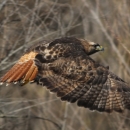Seasons of Wildlife
Waterfowl migrations occur from March to early April and again from September to November. Bird enthusiasts may readily see Canada geese, wood ducks, mallards, blue-winged teal, and hooded mergansers.
Bald eagles nest on the refuge and osprey visit in search of food. Red-tailed hawks and American kestrels are common raptors that nest here.
During the summer shorebirds such as sandpipers and yellowlegs appear in small flocks, feeding on the mudflats.
Generally, birds are best seen early in the morning. Mammals are more likely seen in early morning or at dusk. Learn the habits of the animals that you want to see and plan your trip accordingly. Binoculars and spotting scopes allow you to get a closer look at wildlife without scaring them. Using your car as a blind can also be a good way to observe wildlife. Move slowly and quietly. Animals that hide upon your arrival may return after a short while if you are quiet and still. Use wildlife guides to help identify local plants and animals. Be alert and don’t get discouraged!
Featured Species
Erie is the only refuge in the nation protecting endangered northern riffleshell and clubshell mussels. French Creek, the most biologically diverse stream in Pennsylvania, flows near the Refuge where over 80 species of native fish are found.
The refuge is designated as an Important Bird Area by the National Audubon Society and attracts more than 230 species of birds.



